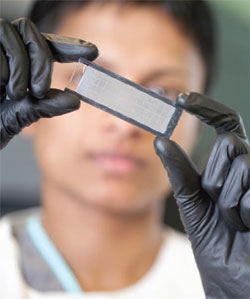



Exploring the ‘Instruction Manual’ that Determines the Good Bird
The US$10-million genomics research collaboration between Cobb, Hendrix Genetics and leading academic institutes, partly funded by the US Department of Agriculture, is now entering its final phase. Dr Rachel Hawken, director of biotechnology, describes the progress achieved over the past four years and why she is so excited about the future in the latest issue of Cobb Focus.
Which key performance traits has the joint project focused on and how will you know if you are successful?
The main effort of the USDA project has focused on weight, breast meat percentage and leg health. The design of the project is to conduct a population-wide genome study to correlate specific DNA genotypes (genetic markers) in elite birds with these key performance traits. Success will be measured by comparison of genetic progress achieved by our traditional pedigree selection program and a selection programme that incorporates DNA markers.
How complete has the chicken genome been sequenced?
The chicken genome was first sequenced in 2004. This effort correctly identified and assigned the DNA sequence for around 85 per cent of the genome. Since then, follow-up efforts in the public sector have been initiated to identify the remaining 15 per cent. At 85 per cent completion, we have enough of the genome identified to develop the tools and databases to study the value of DNA-based selection for the poultry industry.
How many genes does the chicken actually have?
That's a million–dollar question. The problem with counting how many genes is that one gene could exist as a number of different types or be unique enough that we don't recognize them as being genes. This is not only true for the chicken genome, but is also an issue for all sequenced genomes, including human. Gene identification and annotation is the focus of extensive research efforts and intense debate in the genome community. Currently it's estimated that the chicken genome contains between 20,000 and 25,000 genes.
What’s the relationship between these 25,000 genes and the DNA markers you use?
The issue for Cobb as a breeding company is not solely which genes control which traits. This relationship must exist; however, the DNA markers we use determine which pieces of the genome inherited from the parents appear to be important for driving performance in the offspring. The 60,000 DNA makers that we use are distributed evenly along every chromosome of the chicken, independent of the location or identity of specific genes. What we're most interested in is which pieces and versions of the chromosomes passed on from generation to generation are impacting the performance traits that the industry has determined to be of economic value.


So you're not necessarily mapping the genes but have you figured out what good DNA and less good DNA looks like?
That's a good way to put it. In mammals, the genes themselves represent less than two per cent of the whole genome. The rest of the 98 per cent of the genome is made up of DNA that is doing something else. Much of it has been shown to be involved in turning genes on and off. This regulatory activity is key in determining when genes are turned on and off and how 'loud' they are turned on.
The 'fine tuning of gene expression' is controlled by the DNA sequences, and it’s these subtle differences in regulation – the non-gene sequences – that play a big role in making individual animals unique. You and I both have two ears and a chin, but we look different. Not because there are mutations in the genes that are responsible for forming our ears and chin, but more likely the timing and how long the genes are turned on for.
Another way to look at it is eye colour. If you have blue eyes, there’s a 99 per cent chance that you’ve got one particular sequence in a gene that has a single difference (mutation) in the DNA sequence. At that same mutation point if you’ve got a different nucleotide, say an A instead of a G, you’ve an 80 per cent chance of having brown eyes. But eye colour is not quite that simple as there are many different genes that interact together to give the entire spectrum of eye colour. Some differences in the DNA sequences are in the genes themselves, others are in DNA sequences that control the expression of these genes.
So for most things, many genes work together to get the job done and variations in lots of DNA sequences affect most traits?
Absolutely, and that's why this effort becomes very complicated and why we must use thousands of DNA markers to scan the entire genome – what we term genome-wide selection. We expect most of the traits we’re looking at are extremely complex, and we anticipate it’s the interaction of thousands of genes together that’s causing that phenotype (physical trait).
If you think of breast meat percentage, what genes wouldn’t be involved in that? You’ll have genes involved in metabolism, muscle development, and ion transport across cells to make sure every cell has enough oxygen and nutrients. Then there's all the things to do with appetite and growth. There are so many things involved in the breast meat trait alone that instead of just looking at one or two genes, we look at everything together. They call it the infinitesimal model where we anticipate the complex traits result from the interaction of the small effect from thousands of genes.
So how do you decide which pedigree birds are worth selecting as breeders?
We genotype them. The genome selection process sounds quite simple on the surface, but it's not simple at all. We collect the phenotypes on thousands of birds and their genotypes, and we call that the training population. This data set of phenotypes and genotypes is used by our computers to 'learn' and correlate specific DNA sequences with good performance. There's a lot of historical information over generations about which birds and families are better than others, and we look at how those genotypes differ and we train our computer-generated analyses based on that information. Then we can genotype a new population of birds, and based on this we can tell whether any particular chicken has the DNA sequences of a 'good' or a 'bad' bird.
Am I right that with the diminishing cost of this technology, you can now do this across a much wider range of your pedigree population?
Exactly. Advances in genotyping technologies are occurring all the time, mostly driven by the needs and efforts of the human medical community. This has resulted in a significant decrease in the cost of the technology. In addition, as we expand our use of the technology, there are economies of scale to be realised not only by us, but by external genotyping providers that significantly reduces the cost of implementing genome selection in our pedigree program.
So through the project with Hendrix – what's its relevance to moving on with this type of work?
It's one thing to prove that it works and to develop the knowledge and analytical capabilities to use the data. A bigger challenge is how to actually implement the programme into our normal day-to-day operations. What do we need to do at the farm? How fast do we need to get samples to the lab? How fast do we need to get the genotypes back? In all of this technology, what are the glitches?
We've learned a lot about sampling, about sample tracking, sample identification, about genotyping costs and about quality control. And then there’s the benefit in being able to predict their genetic potential before that bird has had a chance to display its phenotypic potential which takes many months. Working together with Hendrix has given each of us a chance to learn how to actually get the work done to generate the data effectively and accurately from thousands of birds in a chicken house. It turns out it's a little bit more of a logistical and operational challenge than having someone with an appointment come into a hospital clinic and provide a blood sample.
You came from a beef cattle research background, and you've dealt with chickens for almost a year now. What's your overriding impression of the difference between the two?
Chickens provide some unique opportunities and challenges that make it very different from conducting genome selection in cattle. The number of chicks produced from a single mating and the amount of selection pres sure you can put on a generation of birds is exponentially greater than that of cattle.
This allows things to move much faster. And as a scientist, seeing things move quickly keeps me excited about the results. The generation time of the bird requires that we conduct our analytical analyses in weeks, versus in cattle where we could take our time over many months. It’s exciting working for a company that has the vision to go down this route, which has the capability to explore this area and has the production system to implement and realise the value that genomic selection has to offer. I knew this would be the case before I arrived here, and it’s very exciting to be in the middle of it actually happening.
What do your Cobb customers say about this work?
They’re excited about the potential, especially the ability to go after hard-to-measure traits like robustness, welfare concerns and disease resistance. Also feed conversion – that’s one that everyone wants Cobb to continue on.
They don’t always understand much about the work we’re doing, but you don’t need to in order to see the potential impact. With the selections based on phenotypes, you can see the progress we’re making by measuring the animal. Now that we’re looking at the DNA, the instruction manual of each bird says whether this bird will be a good bird or a bad bird. Everyone has high expectations, now we have to make sure we deliver on the investment by giving the customer improved products year after year.
February 2012








